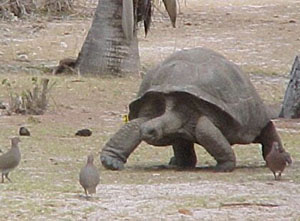
SHIFT FROM ‘TORTOISE CULTURE’ TO ‘EAGLE CULTURE’
Author - VT Joshi

|
SHIFT FROM ‘TORTOISE CULTURE’ TO ‘EAGLE CULTURE’
|

India has to give up its “tortoise culture” and adopt the “eagle culture” to meet the challenge of liberalisation and globalisation of its economy.
Tortoise culture is withdrawal into ones own shell and revelling in its comfort, contentment and security. On the contrary eagle culture is spread of aggressive ideas smacking of a killer instinct. In its very nature tortoise culture is long lasting. Undisturbed by external developments while the eagle culture is constantly exposed to external dangerous and is comparatively short-lived.
A tortoise lives for a couple of hundred years if food is available to it within a short range of a mile or two while the life span of an eagle is hardly about 30 to 40 years.
The very nomenclatures of the two types of culture are symbolic of their character and give a clue to the longevity of Indian civilization while all other contemporary cultures have long ceased to exist, according to the celebrated Management Guru, Sharu Rangnekar.
There was a time in the hoary past of Indian civilization when it was dominated by the “eagle culture” and the message of its rich heritage, arts and industry spread far and wide. Indians were then outgoing, seafaring and spread their influence almost all around the globe.
But the “eagle culture” is not a one-way traffic. While it exports ideas it also brings in foreign ideas. They can at times be dangerous. As it happened in India in its chequered history, resulting in foreign invasions and alien rule, culminating eventually in the East India Company and British domination over the entire subcontinent.
It led to a transformation of the dynamic “eagle” culture into the self-protecting, self-preserving “tortoise” culture. It was epitomized by Mahatma Gandhi’s concepts of village economy. Self sufficiency, rural upliftment, sarvodaya, antyodaya and the like. Contentment was the corner stone of the Gandhian economy and philosophy. Needs must be fulfilled but wants must be minimized.
In such a scheme of things there was no problem of unemployment. A carpenter’s son, for instance became a carpenter. He confined himself to the village and nursed no ambitions. When there were more sons they shared the work however limited it was. They shared their prosperity as well as poverty. There was under employment. However there was contentment in the collective security of the family and village life. The nature of work was also simple, uniform, and unimaginative in all the avocations with very little scope for improvement or innovation.
The one single merit of the tortoise culture was stability. The much needed stability to preserve and protect ones traditional culture in the face of alien ideas. But it also invariably led to stagnation.

GANDHI VS NEHRU
Jawaharlal Nehru did not like the Gandhian philosophy and much less the Gandhian economy. Gandhi said ministers must live in small houses and shun pomp and show, and convert Raj Bhavans into public hospitals. Nehru did not believe in it. When he became Prime Minister he promptly moved into the biggest available house-- the British Commander in Chief’s mansion at Teen Murti in Delhi.
Nehru was an admirer of Stalin and Communism which he euphemistically called socialism. The farmer is the biggest capitalist in the world. He is ready to give up his life for his land. His attachment to his miserable one acre of land is far more intense than possibly Ratan Tata’s to TISCO.
Stalin had to shoot down tens of thousands of farmers to introduce collective farming in the (erstwhile) Soviet Union. But Nehru, essentially a liberal intellectual, could not persuade himself to do it in India.
The essence of Nehruvian economy was central planning, public sector and self reliance to scale and achieve “commanding heights” of national economy. He thought ideal employer-employee relations would achieve wonders for national development and progress. He declared that hoarders, black marketers and profiteers must be hanged from the nearest trees. Perhaps there were not enough trees for the purpose!
Despite its initial glamour and some advantages Nehru’s economic policy did not work. Just as Communism failed in the Soviet Union too.
So resort to liberalization, globalization and market economy in the march of India’s development and progress became inevitable. And whoever was at the helm of (economic) affairs was bound to change tracks – whether it was Narasimha Rao, Manmohan Singh or anyone else.
The change of tracks entails a transition from tortoise culture to eagle culture. Such a transition is an absolute necessity to meet the challenges of free economy and global market that would soon lead to “chaos”, as the famous management expert, Tom peter, has predicted, in the new world order in which anyone can buy and sell anything from anywhere at any price. Productivity Quality and innovation have to be the new watchwords and practiced ruthlessly both for survival and progress. Opportunities have to be watched, anticipated and seized like an eagle.

ANTICIPATE & INNOVATE
Unfortunately most of us want to improve or import new technologies because we don’t want to innovate ourselves for fear of losing ones privileges. The tortoise culture has an inbuilt resistance to change and innovations. The key personnel of the older generation with its privileged perks will always resist innovations of the younger entrants into the industrial structure for fear of loss of face or prestige. The young engineer, who works on the machine on the shop floor, is better equipped to develop bright new ideas and to innovate and take away all the credit than his boss who sits in the room and works on the paper and frowns upon innovations because of his own self-serving interest and preservation.
Even so the future belongs to those who anticipate and innovate at least a few year ahead of others in the challenging competition that stares the new world. And in this, industrial engineers have a vital role and responsibility to discharge.
It is like the ten year old boy who readily sets right a flickering television set, brushing aside his mother or grand mother who fiddles with it without success.
In the fierce global competition and automation the organizational structure of an industrial concern has itself to change radically. The levels of administration and authority have to be reduced drastically.

This article is based on a scintillating extempore speech of the renowned Management Guru, Sharu Rangnekar, at a meeting of the Institute of Industrial Engineers in Bhopal in August 1995.
VT Joshi
August 2005

VT JOSHI (1925-2008) worked for more than fifty years as a journalist. He retired from THE TIMES OF INDIA in 1989. During 1985-89 he was the Special Correspondent of THE TIMES OF INDIA in Pakistan. His books "PAKISTAN: ZIA TO BENAZIR" and "INDIA AT CROSS ROADS" (co-author GG Puri) were widely reviewed in both India and Pakistan.

© All Rights Free